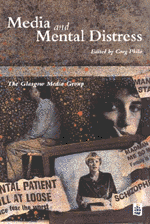

![]()
![]()

Three themes run through the book: the representation of mental distress; the way that audiences receive and recall those representations; and the working practices of the media organizations that produce them. Jenny Secker and Stephen Platt's opening chapter is a literature review of academic studies of the relationship between media coverage and public attitudes to mental health issues. In Chapter 2 Lesley Henderson reports on 15 interviews with television professionals working both in fictional and documentary genres. David Crepaz-Keay writes in Chapter 3 of the way in which the 1994 Boyd Report of the Confidential Inquiry into Homicides and Suicides by Mentally Ill People was covered in the news media. Chapter 4, by Greg Philo, Greg McLaughlin and Lesley Henderson exhaustively taxonomise a large sample of the media coverage of mental illness during April 1993. In Chapter 5 Philo reports on work with six focus groups in and around Glasgow in which people from a wide range of social backgrounds recalled the media coverage of some high profile incidents and reflected on the origins of their own attitudes to people with a mental illness. Finally, in Chapter 6, Philo writes about the perceived impact of media coverage on those suffering mental distress, drawing on interviews with members of user groups and drop-in centres, and with workers in mental health services and voluntary organizations.
From the evidence gathered, two clear findings emerge. First, that much media portrayal is at best sympathetic but unhelpfully simplified (serious illness is resolved by a holiday) and at worst crude (headlines about 'axe maniacs'). Second, that many of those enduring mental distress or working with them find media coverage offensive and believe that it makes their life or the life of those close to them more difficult. This is powerful ammunition for those hoping to alter media representations.
All this rests, however, on the core assumption that media are central to the formation of our beliefs and attitudes. As in previous seminal studies - for example Seeing and Believing (Philo, 1990) - the techniques established by the Glasgow Media Group effectively demonstrate the extent to which we absorb and can reproduce many aspects of media output, whether it is by recalling the details of a high profile criminal episode, creating a passible rendering of tabloid- speak, or recounting soap opera storylines. This study also shows that there is widespread belief that our own and others' attitudes are significantly shaped by media messages. However, we are still dealing with accounts. Philo and his team have not been able to destroy the methodological labyrinth that is media effects research. Several aspects of this are reviewed in Secker and Platt's opening chapter, for example: the multi-dimensional and situational nature of attitudes; the difference between short- and long-term effects; and - crucially - the link between beliefs and behaviour. People may be adept at reproducing Sun-speak but we have no definitive response that papers contradictory defensive postures, that it is at once just a bit of fun understood as such by its audience and a decisive political force.
Faced with this continuing dispute, the least-risk position must be to attempt to influence inaccurate media representations. A better understanding of the conditions under which media are produced is arguably the most promising route to this end, as it both encourages more critical readings of media texts and also enables pressure groups to target approaches to media institutions and personnel more effectively. The two chapters addressing this therefore seem to me to be the most useful - as well as being intrinsically interesting. Crepaz-Key, for example, demonstrates how much the accounts even of 'quality' media rest upon source-provided PR, while Henderson's embedding of media fictional and factual production in the complex web of the appeal to commissioning editors, the search for the audience, narrative convention and pacing, and personal creative standards is fascinating and illuminating.
Meryl Aldridge
School of Sociology and Social Policy, University of Nottingham